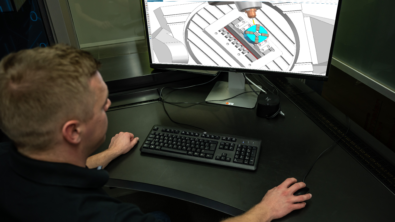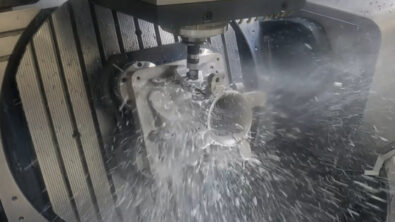Evolution of Tool Paths

How did tool paths get this complicated? This article traces the roots of tool paths evolution.
The primary purpose of modern Computer Aided Machining (CAM) programs is to create efficient tool paths for Computer Numerical Control (CNC) machining. Since machining is a subtractive process, there are at least three measures of tool path efficiency:
- The rate at which material is removed (also known as Material Removal Rate or MRR).
- The overall time required to perform the material removal.
- Tool life.
Computer software engineers have combined with manufacturing experts to create more efficient tool paths over time. The initial CAM tool paths were simply computerized versions of manual tool paths: Zig and Zig-Zag. These motions mimicked the ability of a machinist to feed the table of a manual mill.
Zig signifies one direction cutting. To accomplish this, there are lifts and re-engage motions after every cutting pass. In the pictures below, the light blue color represents cutting passes, while red passes indicate rapid traverse motion, and green represents stepover moves from one cutting pass to another. All pictures are from Siemens PLM NX CAM application.
Zig-Zag eliminates much of the wasted motion at the expense of switching from one-directional milling to two-direction milling (which can be hard on some cutting tools).

Zig and Zig-Zag both do a great job of material removal as long as there are no obstacles. They are not as good for pocketing or working around obstacles. This next image shows a Zig-Zag path inside of an irregular-shaped pocket. The orange area in the second image represents material that is left uncut.

To achieve complete cutting in odd-shaped areas, Offset tool paths were developed. These are created by calculating an offset (usually a percentage of the cutting tool diameter) from the area to be cut. This represents the last pass. Then, an offset is calculated from that offset and so on until the entire area is cut. Below is an example of an offset tool path combined with Zig-Zag (Zig-Zag first and then offset paths to clean up walls). At first, these new tool paths were used to clean up geometry left over from the Zig/Zig-Zag cuts.
Eventually, the technology developed to completely mill an irregular shape using only offset part tool paths.
Offset tool paths are very efficient at covering the entire area to be machined, but they represent a huge problem for manufacturing engineers at the point where two offsets converge at a sharp angle.
The problem is the tool becomes completely embedded in the cut (100% engaged/full width of cutter). That means the feedrate must be slowed down, and there is a tremendous amount of stress put on the cutting tool, which could lead to breakage. This video demonstrates that.
Adding radii at the sharp corners can help, but often you have to make the passes closer together just to assure no material is left between the passes in the acute corners.
To counter that, computer engineers developed a new tool path that allows the tool to “loop” into corners when the tool encounters tool much material.

Trochoidal tool paths can create decreasing spirals to “tornado” material out of a corner.
Another tool path technology also uses a looping method. Instead of just looping in the corners, the entire tool path is a series of loops. This enables the stepovers to be almost completely uniform throughout the tool path. The picture below is a tool path created by VoluMill (NX plug-in milling application from Celeritive Technology).
Today’s modern tool paths engines create efficient cut patterns that remove material quickly and establish long tool life, thereby satisfying our three initial requirements. As long as the subtractive process of milling is required, engineers will be working to improve tool path efficiency through better technology.
All the cut patterns displayed are used for prismatic (2.5D) machining. In a future blog, I will address removing material in 3D manner (multi-axis machining).
About the Author
 | Jim has a Master’s degree in Business Administration from the University of Central Missouri. He has over 30 years of experience in the manufacturing industry, and over 25 years of experience in the CAD/CAM field. He serves as Field Support for Siemens PLM CAM products. Prior to his current role, he held stints as CNC Programmer, CAD/CAM Department Manager, CAD/CAM instructor, and Project Coordinator for Siemens PLM CAM software development. |













